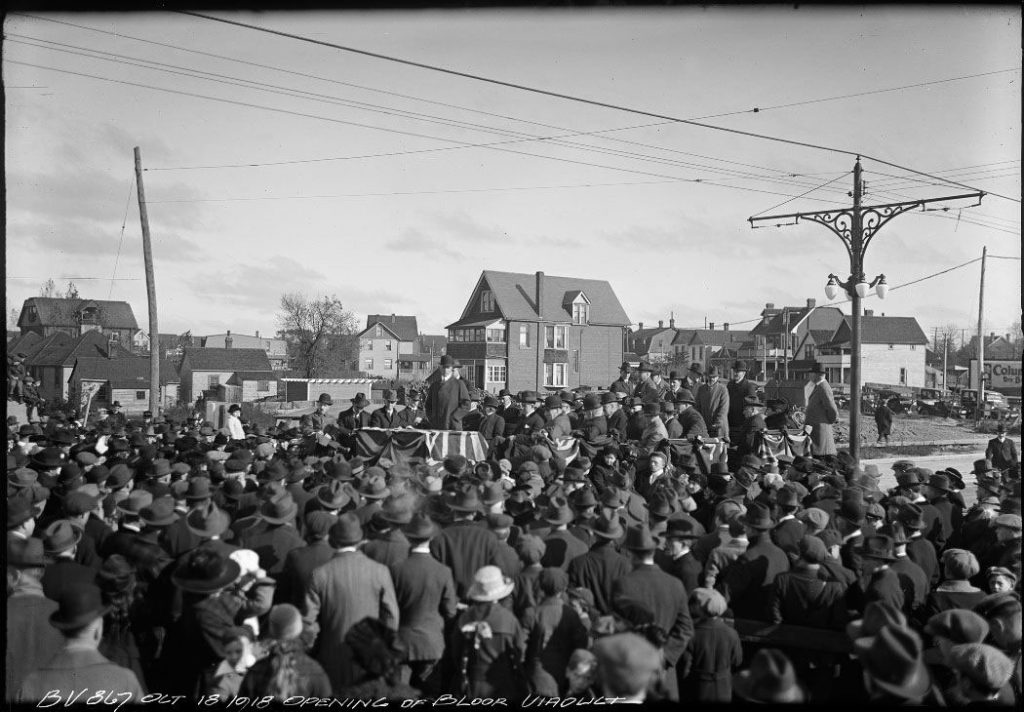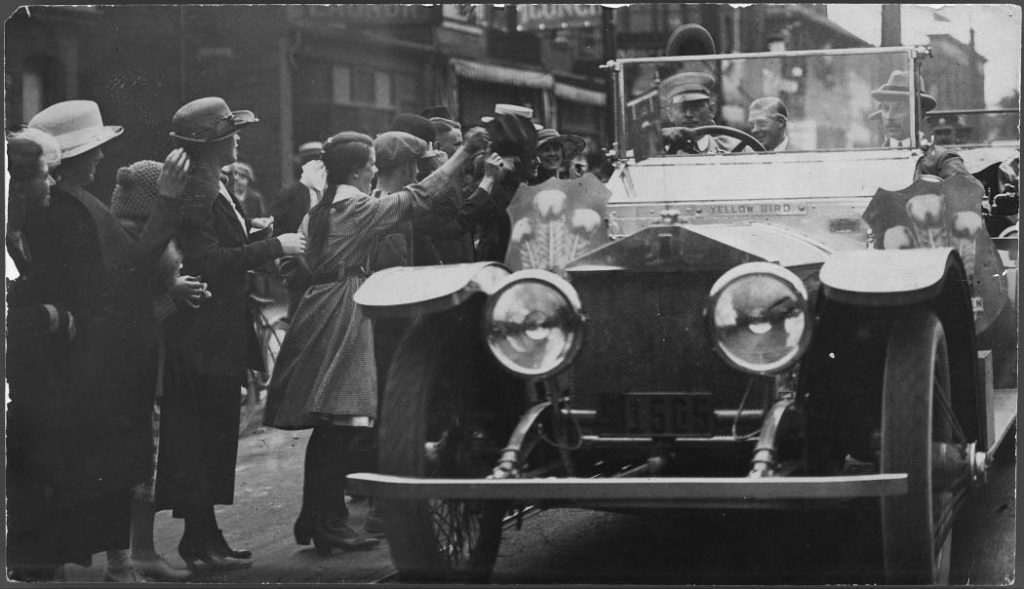

The official opening of the Bloor Viaduct occurred on October 18, 1918, which was when the Don and Rosedale sections were fully completed. The Rosedale bridge had been open for traffic since October 29, 1917, but had temporary roads joining it up to Parliament Street and Castle Frank Road. The Bloor Section was still settling, and its opening was delayed until August 23, 1919.
According to Toronto historian Donald Jones, the official opening “passed virtually unnoticed by the press and the public. It was the final weeks of World War I and the pages of all the Toronto newspapers were filled with news of the war and reports of Canadians who had been killed or wounded. In October of that year, Toronto was also in the midst of one of the most deadly [influenza] epidemics in its history. … On October 18, the day of the official opening of the Don Section, only a small number of officials joined the few spectators who had arrived to witness the ceremonies. Before the fourth speaker had finished his remarks, the mayor, ‘Tommy’ Church called an abrupt halt to the ceremonies. ‘We will not have any more speakers for, if we keep you any longer, we will be violating the Medical Officer’s regulations as to gatherings of people.’”

Despite this inauspicious beginning the Bloor Street Viaduct was a huge success, especially for the people living east of the Don River. The first streetcar crossed the bridge on December 14, 1918, and it wasn’t long before there were traffic tie-ups to rival those of today.

Barely a year after the opening of the viaduct, the City of Toronto welcomed Prince Edward, the Prince of Wales and heir to the English throne. He arrived for a three-day royal visit on August 23, 1919. The Prince was a genuine wartime hero, who had served four years in France. During his visit a huge military gathering was held at the Canadian National Exhibition, with over 40,000 veterans and their families participating. The Prince was immensely popular with the people of Toronto, and shortly after his visit Council petitioned him for permission to name the viaduct after him. The young royal consented, and the name was changed officially on October 6, 1919 to the Prince Edward Viaduct. However, people have continued to use various names for the viaduct even to this day.
These two hand-tinted lantern slides by the Toronto photographer William James are both looking east, but from slightly different vantage points. The left image was taken from the Rosedale Section. The entrance to Drumsnab Road can be seen at the left of the photo. The poles with their decorative ironwork that carry the streetcar wires and overhead lighting are especially striking. The right photograph was taken from the curve of the parapet wall at the north-west end of the Don Section. The two children add a charming touch, and this photograph was published as an exceptionally popular postcard.

In this final image, the gifted photographer M.O. Hammond captured the Prince Edward Viaduct in all of its glory on a beautiful summer day.
Back to introduction
SourcesThe author of this web exhibit thanks the writers of the following works for their documentation of various aspects of the history of the Prince Edward Viaduct. All sources are available at the City of Toronto Archives.Unbuilt Toronto by Mark Osbaldeston, 2008Toronto Architect Edmund Burke: Redefining Canadian Architecture by Angela Carr, 1995A Progressive Traditionalist: John M. Lyle, Architect by Glenn McArthur, 2009“Bridging Politics: A Political History of the Bloor Street Viaduct” by Hans Werner, 1989, Fonds 92, Item 356“The Bloor Street Viaduct, Toronto, Ontario” by Thomas Taylor, published in The Journal of the Engineering Institute of Canada, Volume II, Number 7, July 1919, Fonds 89, File 2“Bridge controversy dissolved when city visited by royalty” by Donald Jones, published in The Toronto Star, November 14, 1987, Fonds 432, File 10